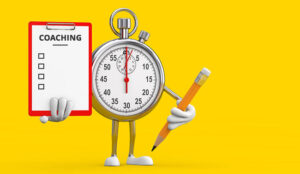Jeremy Watkin of 8×8 shares some of his favourite strategies for improving contact centre coaching.
A person once asked my colleague and contact centre expert Justin Robbins: “How many customer interactions should we evaluate?”
I loved Justin’s simple, straightforward answer: “Evaluate only as many customer interactions as you can coach to.”
Again, the keyword here is coaching. If a major goal of contact centre quality assurance is to evaluate the quality of agent performance, it’s coaching that actually drives improvement.
But this kind of coaching that moves the needle is a bit of an art, requiring practice, and I’ve found that many contact centre leaders (including myself) have some fear and trepidation about it.
So here are some strategies to help improve your coaching practice in the contact centre.
1. Make Time for Coaching
Contact centres are wrought with unplanned events that quickly derail other planned activities — especially those requiring agents to be away from their computers. But if coaching is going to be a priority, you must plan for it.
Build it into your contact centre schedule to ensure that pulling an agent into a 30-minute coaching session doesn’t leave a hole that everyone else must scramble to fill.
Also, this might mean working closely with your workforce management team to identify times where volume is below forecast and doing much of your coaching and development then.
2. Build Connections
I’ve long been a fan of the concept of the emotional bank account from Stephen Covey’s book, The 7 Habits of Highly Effective People.
It’s a simple concept where positive interactions make deposits into another person’s account so that the occasional withdrawal (negative interaction) doesn’t overdraw the account.
It can be easy for coaching to devolve into a gripe session of everything the agent did wrong, but don’t let that happen.
Remember that you’ve invested an incredible amount of time and resources to hire and train this person so you’re vested in their success.
As you coach, take the time to get to know them as a person and make it very clear that, even when delivering difficult feedback, you care deeply about their success.
3. Be Selective. Don’t Pile On
As I said earlier, piling on the negative feedback can quickly overdraw the agent’s emotional bank account.
Great coaches pick a handful of critical behaviours, focus on those until the agent achieves the expectations, and then move on to others.
I suggest beginning with those behaviours that have the greatest impact on the customer experience — like the accuracy of the information provided to customers and security and compliance procedures.
4. Give Complete Feedback
If you are going to coach an agent, don’t go halfway and only show them part of the picture.
Speak to as much of the customer interaction as you possibly can. If evaluating a phone conversation it sure helps to have screen recording to not only speak to their demeanour with the customer but also the way they navigated their tools during the conversation.
Let’s imagine that one of your coaching points is: “You need to leave more thorough notes on the account at the end of the call”
The agent might respond by saying: “I don’t have enough time before my next call to be more thorough.”
When reviewing the screen recording you may notice a minute somewhere in the middle of the call where the customer was trying something on their end and the agent was idle.
With that insight, you not only support your point that the agent should leave more thorough notes but you can encourage them to start writing their notes during those idle times before the call concludes.
5. Be Specific
The more specific you can be in the coaching session, the more likely the agent is to “get it” and actually improve.
Review specific moments in interactions that require improvement, and either model a better way to handle the situation or, better, show them an example.
Quality management software features conversation tagging which allows coaches to tag agents at specific moments in a call and highlight and save portions of exemplary interactions, so agents can learn from their peers.
6. Lead With the Feedback, Not the Score
Quality scores are important, but not during a coaching conversation. It’s important to be able to track how the team and individual agents are progressing on their various required behaviours, and quality scores are useful for this. But the problem with scores in a coaching conversation is that the agent’s eyes go straight to the score.
There are a couple of drawbacks to this. Going back to my earlier example of incomplete notes, an agent may see their passing score even though their notes were incomplete, and opt to completely disregard the feedback.
On the flip side, if the agent sees a big fat F for a score, their fight or flight response is activated. At that point, they are more concerned about whether they need to look for a new job and may not hear a word you say after that.
7. Connect to the Bigger Purpose
It’s so easy to jump into a coaching session, focusing on each behaviour, without tying them back to the larger goal.
For example, many contact centres require their agents to ask some variation of: “Is there anything else I can help you with,” at the end of an interaction. This phrase, while well-intentioned, is so often used by agents to more quickly end a call.
Does anyone stop to think about why this phrase is important and communicate that to the agents?
We ask this question to ensure that the customer has received an accurate, and thorough response to the issue they called about.
Unresolved issues and additional effort required to contact customer service are huge drivers in customers choosing to take their business elsewhere.
Coaches should be able to clearly articulate the impact each behaviour has on the customer experience so agents understand the importance of their work.
Speech analytics makes it easy to locate calls that include common phrases, ensuring not only that those phrases are being used, but that they are being used appropriately.
8. Set and Review Goals
When it comes to employee development, each coaching session should build on the last one.
Before concluding, the supervisor and agent should agree on goals, those behaviours they will work to improve until they meet again.
All subsequent coaching sessions should begin by reviewing those goals and discussing the agent’s progress toward achieving them.
In my contact centre career, I have been a part of (and likely the cause of) quality coaching sessions that were outright combative and others with little to no coaching conversation.
Both formats were equally ineffective and did nothing to improve quality in the contact centre.

Jeremy Watkin
Instead, by using these conversations as a way to connect with my agents, focusing on their long-term development, and constantly pointing back to the outcomes we were working together to achieve, I found that both the quality and outcome of my coaching sessions significantly improved.
As you hone your own coaching practice, I hope these strategies will benefit you and your contact centre.
Author: Robyn Coppell
Published On: 27th Aug 2020 - Last modified: 2nd Sep 2020
Read more about - Guest Blogs, 8x8




































